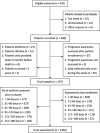Transitions in Prognostic Awareness Among Terminally Ill Cancer Patients in Their Last 6 Months of Life Examined by Multi-State Markov Modeling
- PMID: 28684551
- PMCID: PMC5599205
- DOI: 10.1634/theoncologist.2017-0068
Transitions in Prognostic Awareness Among Terminally Ill Cancer Patients in Their Last 6 Months of Life Examined by Multi-State Markov Modeling
Abstract
Background: Developing accurate prognostic awareness, a cornerstone of preference-based end-of-life (EOL) care decision-making, is a dynamic process involving more prognostic-awareness states than knowing or not knowing. Understanding the transition probabilities and time spent in each prognostic-awareness state can help clinicians identify trigger points for facilitating transitions toward accurate prognostic awareness. We examined transition probabilities in distinct prognostic-awareness states between consecutive time points in 247 cancer patients' last 6 months and estimated the time spent in each state.
Methods: Prognostic awareness was categorized into four states: (a) unknown and not wanting to know, state 1; (b) unknown but wanting to know, state 2; (c) inaccurate awareness, state 3; and (d) accurate awareness, state 4. Transitional probabilities were examined by multistate Markov modeling.
Results: Initially, 59.5% of patients had accurate prognostic awareness, whereas the probabilities of being in states 1-3 were 8.1%, 17.4%, and 15.0%, respectively. Patients' prognostic awareness generally remained unchanged (probabilities of remaining in the same state: 45.5%-92.9%). If prognostic awareness changed, it tended to shift toward higher prognostic-awareness states (probabilities of shifting to state 4 were 23.2%-36.6% for patients initially in states 1-3, followed by probabilities of shifting to state 3 for those in states 1 and 2 [9.8%-10.1%]). Patients were estimated to spend 1.29, 0.42, 0.68, and 3.61 months in states 1-4, respectively, in their last 6 months.
Conclusion: Terminally ill cancer patients' prognostic awareness generally remained unchanged, with a tendency to become more aware of their prognosis. Health care professionals should facilitate patients' transitions toward accurate prognostic awareness in a timely manner to promote preference-based EOL decisions.
Implications for practice: Terminally ill Taiwanese cancer patients' prognostic awareness generally remained stable, with a tendency toward developing higher states of awareness. Health care professionals should appropriately assess patients' readiness for prognostic information and respect patients' reluctance to confront their poor prognosis if they are not ready to know, but sensitively coach them to cultivate their accurate prognostic awareness, provide desired and understandable prognostic information for those who are ready to know, and give direct and honest prognostic information to clarify any misunderstandings for those with inaccurate awareness, thus ensuring that they develop accurate and realistic prognostic knowledge in time to make end-of-life care decisions.
摘要
背景. 预后意识是做出基于偏好的临终(EOL)关怀决定的基石, 形成准确的预后意识是一个涉及更多预后意识状态的动态过程, 而不仅仅是了解或不了解预后。了解每种预后意识状态的转变概率和时间耗费可以帮助临床医生识别触发因素, 以促进转变为准确的预后意识。研究检测了247名癌症患者在生命最后6个月的连续时间点之间不同预后意识状态的转变概率, 并估计了每种状态的时间耗费。
方法. 预后意识被分为四种状态:(a)状态1:不了解且不想了解;(b)状态2:不了解但想了解;(c)状态3:意识不准确;(d)状态4:意识准确。转变概率通过多维状态马尔科夫模型检测获得。
结果. 最初, 59.5%的患者具有准确的预后意识, 而处于状态1‐3的概率分别为8.1%、17.4%和15.0%。患者的预后意识通常保持不变(保持在同一状态的概率:45.5%–92.9%)。如果患者预后意识改变, 则预后意识倾向于转变为更高的状态(最初处在状态1‐3的患者转变为状态4的概率为23.2%‐36.6%, 处在状态1和2的患者转变为状态3的概率为9.8%–10.1%)。估计这些患者在生命的最后6个月中处于状态1‐4的时间分别为1.29、0.42、0.68和3.61个月。
结论. 终末期癌症患者的预后意识通常比较稳定, 倾向于对其预后的意识越来越准确。医疗保健专业人员应及时帮助患者转变为准确的预后意识, 以使其做出基于偏好的EOL关怀决定。
Keywords: Awareness; Multi‐state model; Neoplasms; Prognosis; Prognostic awareness; Transitions.
© AlphaMed Press 2017.
Conflict of interest statement
Disclosures of potential conflicts of interest may be found at the end of this article.
Figures



Similar articles
-
Preferences for Life-Sustaining Treatments and Associations With Accurate Prognostic Awareness and Depressive Symptoms in Terminally Ill Cancer Patients' Last Year of Life.J Pain Symptom Manage. 2016 Jan;51(1):41-51.e1. doi: 10.1016/j.jpainsymman.2015.08.006. Epub 2015 Sep 18. J Pain Symptom Manage. 2016. PMID: 26386187
-
Factors Predisposing Terminally Ill Cancer Patients' Preferences for Distinct Patterns/States of Life-Sustaining Treatments Over Their Last Six Months.J Pain Symptom Manage. 2019 Feb;57(2):190-198.e2. doi: 10.1016/j.jpainsymman.2018.11.008. Epub 2018 Nov 15. J Pain Symptom Manage. 2019. PMID: 30447386
-
Accurate Prognostic Awareness Facilitates, Whereas Better Quality of Life and More Anxiety Symptoms Hinder End-of-Life Care Discussions: A Longitudinal Survey Study in Terminally Ill Cancer Patients' Last Six Months of Life.J Pain Symptom Manage. 2018 Apr;55(4):1068-1076. doi: 10.1016/j.jpainsymman.2017.12.485. Epub 2017 Dec 29. J Pain Symptom Manage. 2018. PMID: 29289656
-
Prognostic awareness in advanced cancer: an integrative literature review.BMJ Support Palliat Care. 2021 Mar;11(1):53-58. doi: 10.1136/bmjspcare-2020-002287. Epub 2020 Sep 4. BMJ Support Palliat Care. 2021. PMID: 32887727
-
The trajectory of prognostic cognition in patients with advanced cancer: is the traditional advance care planning approach desirable for patients?Jpn J Clin Oncol. 2024 May 7;54(5):507-515. doi: 10.1093/jjco/hyae006. Jpn J Clin Oncol. 2024. PMID: 38336476 Free PMC article. Review.
Cited by
-
What Have You Been Told? Awareness of Prognosis of Patients in an Italian Home Palliative Care Service.Palliat Med Rep. 2025 Feb 10;6(1):17-27. doi: 10.1089/pmr.2024.0072. eCollection 2025. Palliat Med Rep. 2025. PMID: 40171211 Free PMC article.
-
Communication in Cancer Care in Asia: A Narrative Review.JCO Glob Oncol. 2023 Jun;9:e2200266. doi: 10.1200/GO.22.00266. JCO Glob Oncol. 2023. PMID: 37364221 Free PMC article. Review. No abstract available.
-
Prognostic disclosure in oncology - current communication models: a scoping review.BMJ Support Palliat Care. 2022 Jun;12(2):167-177. doi: 10.1136/bmjspcare-2021-003313. Epub 2022 Feb 10. BMJ Support Palliat Care. 2022. PMID: 35144938 Free PMC article.
-
Hope and illness expectations: A cross-sectional study in patients with advanced cancer.Palliat Med. 2024 Jan;38(1):131-139. doi: 10.1177/02692163231214422. Epub 2023 Dec 12. Palliat Med. 2024. PMID: 38087831 Free PMC article.
-
The Effect of Prognostic Communication on Patient Outcomes in Palliative Cancer Care: a Systematic Review.Curr Treat Options Oncol. 2020 Apr 23;21(5):40. doi: 10.1007/s11864-020-00742-y. Curr Treat Options Oncol. 2020. PMID: 32328821 Free PMC article.
References
-
- Weeks JC, Cook EF, O'Day SJ et al. Relationship between cancer patients' predictions of prognosis and their treatment preferences. JAMA 1998;279:1709–1714. - PubMed
-
- Ahn E, Shin DW, Choi JY et al. The impact of awareness of terminal illness on quality of death and care decision making: A prospective nationwide survey of bereaved family members of advanced cancer patients. Psychooncology 2013;22:2771–2778. - PubMed
-
- Lee MK, Baek SK, Kim SY et al. Awareness of incurable cancer status and health‐related quality of life among advanced cancer patients: A prospective cohort study. Palliat Med 2013;27:144–154. - PubMed
-
- Tang ST, Liu TW, Tsai CM et al. Patient awareness of prognosis, patient–family caregiver congruence on the preferred place of death, and caregiving burden of families contribute to the quality of life for terminally ill cancer patients in Taiwan. Psychooncology 2008;17:1202–1209. - PubMed
Publication types
MeSH terms
LinkOut - more resources
Full Text Sources
Other Literature Sources

